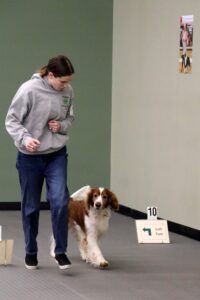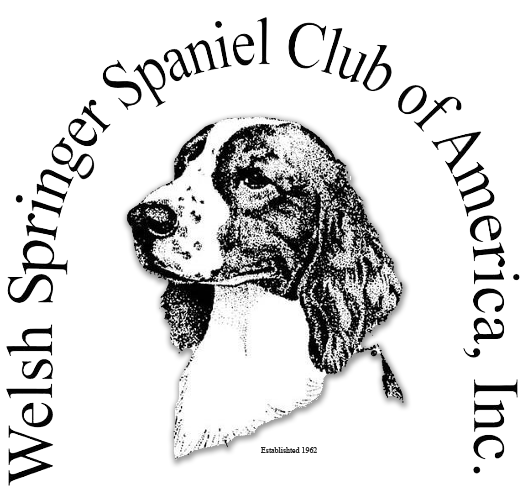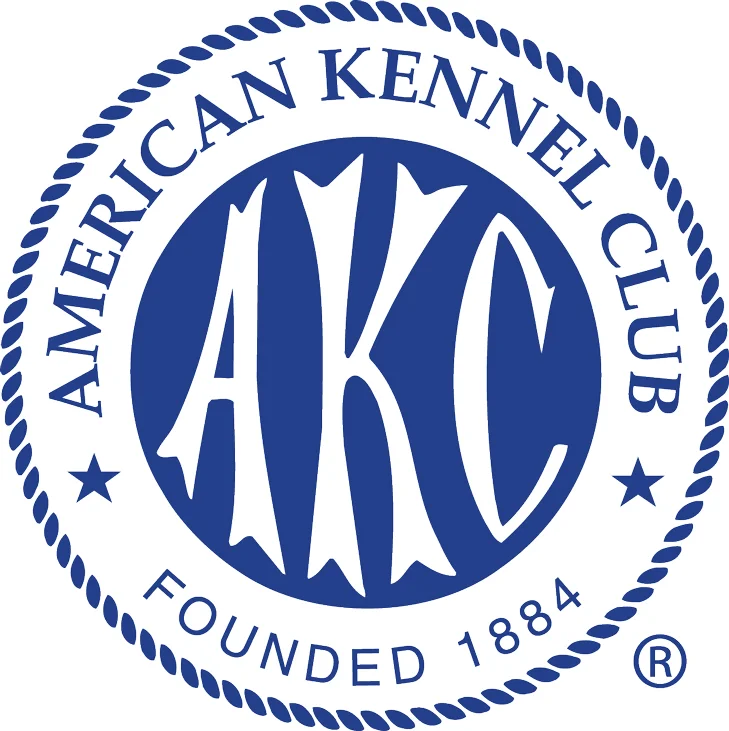Menu

Rally
If obedience seems too formal and patterned and agility seems too fast-paced, then RALLY might be the sport for you. Rally incorporates the team moves of obedience training with the course concept of agility, resulting in a fun showing environment perfect for those new to competition as well as seasoned teams who want to enjoy more ring time.
The AKC website has extensive resources to learn about getting started in and participating in Rally.
What makes Rally interesting is that each competition has a different course, designed by the trial’s judge. The judge sets up a series of exercises that the dog/handler team must perform at a brisk pace. The exercises are identified by colorful signs – teams move through the course completing each sign in turn. The signs may ask for traditional obedience exercises (HALT-DOWN-WALK AROUND DOG), “doodling” exercises (CIRCLE RIGHT), or more unusual moves (such as a SERPANTINE where the handler and dog weave through a series of plastic cones). Exercises are either moving (such as FAST or 270 LEFT) or stationary (any exercise with the dog stopping).
Perhaps the most significant difference from obedience competition is that in Rally, handlers are allowed to talk to the dog and use hand signals throughout the course. Handlers can give verbal commands, but also praise and reinforce the dog. This communication is more like training, or like your normal, everyday interactions with your dog. In the beginning classes, handlers may also pat their legs or clap their hands to encourage their dogs. So dogs can get a LOT of information from their handlers in Rally.
GETTING STARTED IN RALLY
The place to start is akc.org where you can find the signs and descriptions of each exercise. Then, go to a trial! Look at the course to get a sense of the flow of each class. Watch the teams competing and imagine yourself out in the ring. It’s a great sport for everyone, both as a confidence-builder and a way to have fun with your dog.
Overview of a Rally Trial
In competition, teams begin with a perfect score of 100. Then, as the team follows the course, the judge may take deductions when errors are made. A score of 70 or better is needed to qualify, and the team must have attempted each of the exercises in the course. Teams are timed on their runs, but time is only used to break ties in scores. Shortly after each team runs the course, the gate steward will post their scores, so you’ll know right away if you’ve qualified. But they don’ list the time the run took. This allows some suspense – for example, if two dogs earned 100’s, they won’t know until the ribbons are awarded which team got 1st place (the team with the faster time).
Typical errors in rally include a tight leash (for Novice), not working as a team, dog out of position, or the ever-present handler error. One to ten points can be deducted for each exercise. If a team attempts an exercise and does not complete it successfully, they may reattempt the same exercise. Unfortunately, the judge will not give the handler any feedback, so the handler must make the decision to reattempt the exercise or not. The stakes are large – an incorrect exercise will lose the team 10 points. But if the team retries and succeeds, the total deduction will only be 3 points. So handlers do need to understand each exercise.
The intent of Rally, though, is for teams to have fun in an event that has challenges, but where most dogs can succeed. The atmosphere at trials is generally friendly and encouraging. Rally can be the “bridge” between training and formal obedience, or just a great way to spend time with your favorite four-legged pal.
Competive Classes
The AKC offers competition in three levels: Novice, Advanced and Excellent. To earn a title, the dog/handler teams must receive three qualifying scores under at least two different judges. In each level, “A” and “B” classes are offered, which helps even out the competition, with the more experienced dogs and handlers showing in the “B” classes.
Novice
The NOVICE class is the beginning level and the dog is on-leash throughout the course. Novice courses have between 10-15 exercises and no more than 5 stationary exercises will be included. The exercises are less complex than in the other two classes, but the handlers must learn to follow the signs smoothly and keep on course. Sometimes that is a challenge, as agility competitors will attest!
Handlers may show in Novice A if they have not earned a rally or obedience title on ANY dog and if they own the dog being shown. Everyone else must show in Novice B.
Advanced
The ADVANCED class is the next level of competition and the dog is off-leash. The courses in Advanced include 12-17 exercises, including 1 jump, with no more than 7 stationary ones. The difference between Novice and Advanced is pretty significant – there are more challenging exercises and the teams must work without the safety net of the leash. But, you may continue to clap your hands or pat your leg in this class.
Handlers may show dogs in Advanced A if the dog has not earned any obedience title, and if they own the dog. Everyone else shows in Advanced B.
Excellent
The EXCELLENT class is the highest level of competition in Rally. The dog is off-leash for all but the HONOR DOG exercise, and handlers may no longer clap their hands or pat their legs. The courses include 15-20 exercises, including 2 jumps, and may have no more than 7 stationary exercises. The Excellent class doesn’t include many new exercises, but the ones it has are tricky, such as backing up or the moving stand (without touching the dog).
Handlers may show in Excellent A if the dog has not earned an obedience title and is owned by the handler. Everyone else shows in Excellent B.
A note about the jumps in rally – there are only three categories for jump heights: 8, 12, or 16 inches. The correct jump height must be indicated on the entry form. The jump can be any of the obedience jumps: high jump, bar jump, or broad jump. (The broad jump will be twice the height of the high or bar jump.)
Rally Titles
With three qualifying scores, dogs will earn their Rally Novice title, and then may add RN after their registered name. Then, dogs may earn the Rally Advanced (RA) and Rally Excellent (RE).
Once a dog has earned the RE, handlers may compete for the Rally Advanced Excellent title. For this title, the teams must qualify 10 times in BOTH Advanced B and Excellent B (at the same trial). The RAE title may be earned multiple times and is then designated as RAE2 or RAE3, etc.

